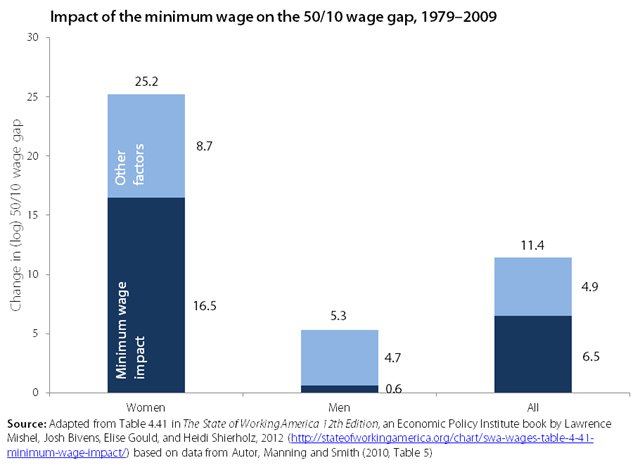Sottotitolo:
There can be no doubt that the minimum wage affects the lowest-paid workers, possibly as much as the bottom fifth of wage earners.
A higher minimum wage is an important way to address wage inequality, as the erosion of the minimum wage is the main reason for the increase in inequality between low-and middle-wage workers (in particular the 50/10 wage gap, that between the median and the 10th percentile earner). This is particularly true among women, the group for whom the wage gap in the bottom half grew the most.
As the figure below shows, two-thirds of the increase in the 50-10 wage gap can be attributed to the erosion of the real value of the minimum wage. [The 50/10 wage gap grew 25.2 (log) percentage points between 1979 and 2009 and that two-thirds of this increase (16.5 percentage points, or 65 percent of the total) can be attributed to the erosion of the minimum wage.] The paper this figure draws on usefully and appropriately captures the spillover impact of the minimum wage—the impact on those earning above the legislated rate.
This finding makes sense, since it was in the 1980s that the minimum wage eroded the most, and that was the same time period when the 50/10 wage gap among women expanded greatly. The erosion of the minimum wage explains over a tenth (11.3 percent) of the smaller 5.3 (log) percentage point expansion of the 50/10 wage gap among men. For workers overall more than half (57 percent) of the increase in the 50/10 wage gap was accounted for by the erosion of the minimum wage.

Some recent discussion of the minimum wage and overall inequality has focused on the degree to which a higher minimum wage diminishes poverty.
I would just point out that the minimum wage is established by the Fair Labor Standards Act and is a wage floor—a labor standard that assures no one earns less than a certain amount and limits the downward pressure on wages. A higher minimum wage also, as noted above, affects those who earn slightly more than the legislated minimum, as employers maintain some differentials between the legislated minimum and the wage rates provided in certain occupations. The issue is sometimes raised, as the, as to whether the minimum wage is ‘well-targeted.’
This, to me, is somewhat of a distraction: there can be no doubt that the minimum wage affects the lowest-paid workers, possibly as much as the bottom fifth of wage earners. That is, by definition, a policy that is targeted at low-wage earners. There are substantial numbers of workers earning poverty-level wages: in 2012, a worker earning $11.29 per hour and who worked full-time and year round would be at the poverty line for a four-person family.
More than a fourth of men and over thirty percent of women in the child-raising ages of 25-34 earned poverty-level wages in 2012, a share that doubled (from 10.8 percent) among men and barely budged among women since 1979. It is fine with me if a higher minimum wage supports greater wage growth at the bottom and also benefits households in the second or middle fifth of the household income distribution: David Cooper’s research shows that roughly seventy percent of the workers benefitting from a $10.10 minimum wage live in families making $60,000 a year or less.
- See more at: http://www.epi.org/blog/tight-link-minimum-wage-wage-inequality/?utm_source=Economic+Policy+Institute&utm_campaign=9c852185dc-NYT_Minimum_Wage_Editorial_02_10_20142_10_2014&utm_medium=email&utm_term=0_e7c5826c50-9c852185dc-55919081#sthash.eElBi6nK.dpuf









